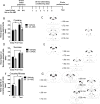Role of perineuronal nets in the anterior dorsal lateral hypothalamic area in the acquisition of cocaine-induced conditioned place preference and self-administration
- PMID: 28322980
- PMCID: PMC5492967
- DOI: 10.1016/j.neuropharm.2017.03.018
Role of perineuronal nets in the anterior dorsal lateral hypothalamic area in the acquisition of cocaine-induced conditioned place preference and self-administration
Abstract
Addiction involves drug-induced neuroplasticity in the circuitry of motivated behavior, which includes the medial forebrain bundle and the lateral hypothalamic area. Emerging at the forefront of neuroplasticity regulation are specialized extracellular matrix (ECM) structures that form perineuronal nets (PNNs) around certain neurons, mainly parvalbumin positive (PV+), fast-spiking interneurons (FSINs), making them a promising target for the regulation of drug-induced neuroplasticity. Despite the emerging significance of PNNs in drug-induced neuroplasticity and the well-established role of the lateral hypothalamic area (LHA) in reward, reinforcement, and motivation, very little is known about how PNN-expressing neurons control drug-seeking behavior. We found that a discrete region of the anterior dorsal LHA (LHAad) exhibited robust PNN and dense ECM expression. Approximately 87% of parvalbumin positive (PV+) neurons co-expressed the PNN marker Wisteria floribunda agglutinin (WFA), while 62% of WFA positive (WFA+) neurons co-expressed PV in the LHAad of drug naïve rats. Removal of PNNs within this brain region via chrondroitinase ABC (Ch-ABC) administration abolished acquisition of cocaine-induced CPP and significantly attenuated the acquisition of cocaine self-administration (SA). Removal of LHAad PNNs did not affect locomotor activity, sucrose intake, sucrose-induced CPP, or acquisition of sucrose SA in separate groups of cocaine naïve animals. These data suggest that PNN-dependent neuroplasticity within the LHAad is critical for the acquisition of both cocaine-induced CPP and SA but is not general to all rewards, and that PNN degradation may have utility for the management of drug-associated behavioral plasticity and memory in cocaine addicts.
Keywords: Addiction; Cocaine; Conditioned place preference; Dorsal anterior lateral hypothalamic area; Drug-associated memory; Extracellular matrix; Perineuronal nets; Self-administration.
Published by Elsevier Ltd.
Figures




References
-
- Kalivas PW, O’Brien C. Drug addiction as a pathology of staged neuroplasticity. Neuropsychopharmacology. 2008;33:166–180. - PubMed
-
- Nieuwenhuys R, Geeraedts LM, Veening JG. The medial forebrain bundle of the rat. I. General introduction. J Comp Neurol. 1982;206:49–81. - PubMed
-
- Valenstein ES, Campbell JF. Medial forebrain bundle-lateral hypothalamic area and reinforcing brain stimulation. Am J Physiol. 1966;210:270–274. - PubMed
-
- Margules DL, Olds J. Identical “feeding” and “rewarding” systems in the lateral hypothalamus of rats. Science. 1962;135:374–375. - PubMed
-
- Olds J, Olds ME. The mechanisms of voluntary behavior. In: Heath RG, editor. The Role of Pleasure in Behavior. Hoeber; New York: 1964.
MeSH terms
Substances
Grants and funding
LinkOut - more resources
Full Text Sources
Other Literature Sources

